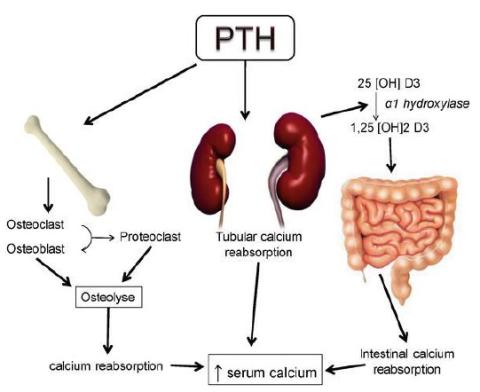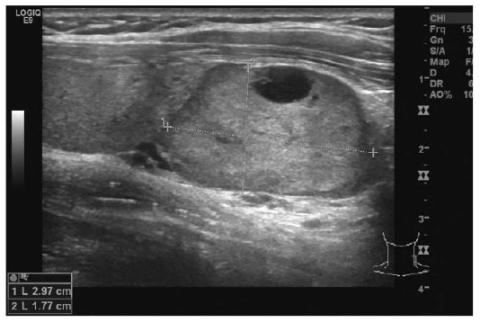The Amazing Parathyroid Gland: Small but Mighty!
Most individuals are familiar with the major organs of the human body such as the heart, lungs, liver, and kidneys. However, fewer people are knowledgeable about the smaller organs such as the pituitary gland, the adrenal glands, the lymph nodes, or the parathyroid glands, even though their functions are still vital for life. This article examines the tiny parathyroid glands and their physiologic role and importance to our bodies.
The parathyroid glands are four tiny organs that are located behind the much larger thyroid gland in the front part of the neck (Fig. 1). Their function is neither associated with nor dependent on the thyroid gland itself. A normal parathyroid gland is 0.3 to 0.5 cm in size, which is approximately the size of a grain of rice cut in half. The human body can continue normally even if three of the four parathyroid glands are removed surgically. However, the function of the tiny parathyroid is so important that death results if the remaining fourth gland were to be removed.
The parathyroid glands were first identified by Swedish medical student Ivar Sandström in 1877, and the findings were subsequently published in 1880. 1 The importance of the parathyroid glands was demonstrated by French physiologist Eugène Gley (1857–1937). He surgically removed the four glands in laboratory animals, all of which quickly died due to tetany (uncontrolled muscular spasm). 2 The parathyroids exert their effects in the body by the secretion of parathormone (PTH), a polypeptide hormone identified by Rasmussen and Craig in 1959. 3 These early findings established the critical function of the parathyroid glands.
The function of the parathyroid glands relates to the control of calcium metabolism, acting as a regulator to ensure calcium levels remain stable. Calcium is a critical component of the body, which is essential for muscle contraction, heart activity, nerve function, and clotting to name just a few. The calcium level in the blood is required to be within a narrow band of 8.5 to 10.2 mg/dL to be in good health, and the parathyroid glands orchestrate several organs of the body to maintain this level continuously. The parathyroid glands sense if the calcium level is too high or too low and make the necessary adjustments to maintain normal values. How does this happen?
Specialized receptors in the cells of parathyroid tissue (Calcium Sensing Receptors) respond to the calcium level in the blood stream. A low calcium level triggers the cells to secrete PTH into the circulation. A high level of calcium in the blood conversely inhibits the release of PTH. 4 PTH then travels via the blood stream to affect the kidneys, bones, and intestines to achieve the needed change in calcium. Human bones are about 65% calcium which represents a major storehouse for calcium that can be accessed as needed by the body. PTH stimulates the release of calcium from the bones when the calcium level is low. The kidneys can readily excrete or conserve calcium depending on the influence of PTH. They excrete calcium when the level is too high and will retain calcium when the level is low. Our only external source of calcium is through our diet, and consequently the intestines play a role in calcium metabolism. PTH promotes calcium absorption from the small intestine when serum calcium levels are low. Thus, we see finely tuned orchestration of the parathyroid glands to maintain a normal level of calcium in the blood stream by affecting the bones, kidneys, and intestine (Fig. 2).
This “complicated machinery” that ensures a normal calcium level in the bloodstream raises the question of what happens when there is a defective process in the system. Our health is adversely affected if serum calcium level is too low (hypoparathyroidism) or if the level is too high (hyperparathyroidism). What happens when the calcium level is too low?
Low calcium levels in the blood (caused by hypoparathyroidism) initially cause muscle cramps and twitching and can lead to more long-term conditions and illness. Patients can develop depression and memory loss. As the calcium levels continue to fall both seizure activity and heart failure can appear. Long term hypoparathyroidism leads to osteoporosis and predisposition to bone fractures. Critically low calcium levels cause muscular tetany and death. The most common cause for hypoparathyroidism in clinical practice is surgical injury or excision of the parathyroid glands associated with surgery on the much larger thyroid gland. However, there are treatments that can help remedy these conditions. Hypoparathyroidism can usually be treated with oral calcium and vitamin D supplements. Intravenous calcium can be given in more urgent situations.
Likewise, high calcium levels in the blood (caused by hyperparathyroidism) can also prove to be problematic and be associated with nausea, vomiting, constipation, fatigue, and weakness. Patients may have increased thirst, confusion, lethargy, and palpitations. Kidney stones arise from an increased excretion of calcium in the urine. Pancreatitis and bone fragility can occur. In extreme situations, untreated hypercalcemia can lead to coma. The most common clinical cause for hypercalcemia caused by hyperparathyroidism is a small tumor in the parathyroid gland itself (parathyroid adenoma). The adenoma secretes large amounts of PTH into the bloodstream in a continuous fashion without regard for elevated calcium in the blood. Parathyroid adenomas are small, typically the size of a peanut, and can be located in any of the four parathyroid glands. Parathyroid adenomas are typically excised surgically with good outcomes.
Surgical exposure and identification of parathyroid glands is not easily accomplished. The glands are small and can be easily missed or confused with surrounding tissues such as lymph nodes, fatty tissue, or adjacent thyroid tissue. Operative dissection must be precise, and the operative field must be dry without bleeding to allow their visualization. The surgeon may be assisted with preoperative scanning to help identify the position of the parathyroid adenoma. A normal size parathyroid gland is typically too small to be reliably identified by any scan. However, a parathyroid adenoma is sufficiently enlarged to be identified on several types of scanning, including high resolution ultrasonography, Technetium-99 sestamibi scan, thin slice computerized tomography, and nuclear magnetic resonance scanning of the neck. 5 The choice of scanning would be selected by the managing physician, but ultrasonography is usually the most costeffective option (Fig. 3). Despite some surgical challenges present in locating the adenoma, the clinical success rate for excision of a parathyroid adenoma (with normalization of calcium levels) is above 95%. 6
The parathyroid glands have a critically important role in maintaining a safe level of calcium in our blood. Fluctuations in calcium levels, either too high or too low, have major consequences for our health. There is a complicated but effective relationship between the parathyroid glands, the kidneys, the bones, and the intestines to ensure that calcium remains at a normal level. The human body also has other complicated but effective mechanisms to maintain safe levels of sodium, potassium, glucose, oxygen, bicarbonate, carbon dioxide, red cells, white cells, platelets, albumin, and many other proteins in our blood. How does the body know how to manage all these systems simultaneously? How does the body know when to respond to adverse events, how much response is needed, and how quickly the response much be implemented?
The answer to these questions is seen in Psalm 139:13–15:
For you created my inmost being;
you knit me together in my mother’s womb.
I praise you because I am fearfully and wonderfully made;
your works are wonderful,
I know that full well.
My frame was not hidden from you
when I was made in the secret place,
when I was woven together in the depths of the earth (NIV). 7
The level of intelligence required to design and create all the complicated machinery required to sustain our state of normalcy is beyond our comprehension. Complicated engines require an intelligent engineer. The lowly parathyroid gland is certainly a tiny (but mighty!) component of the human body. However, this tiny component is essential for life to continue. Consider what the Apostle Paul says in 1 Corinthians 12:21–22:
The eye cannot say to the hand, “I don’t need you!” And the head cannot say to the feet, “I don’t need you!” On the contrary, those parts of the body that seem to be weaker are indispensable, and the parts that we think are less honorable we treat with special honor (NIV).Error! Bookmark not defined.
When a disease process is identified, the tiny parathyroid glands are certainly treated with “special honor” involving either a medical or surgical approach required to return the patient to normal calcium metabolism. Collectively the parathyroid glands represent only one small aspect of the complexity of the human body. The amazing control mechanisms of all our body systems speak to the glory of our powerful and loving creator, Jesus Christ.
- 1Johansson H (2015) The Uppsala anatomist Ivar Sandström and the parathyroid gland. UPS J Med Sci. 120(2):72–77. https://www.ncbi.nlm.nih.gov/pmc/articles/PMC4463479/ Accessed 2023 Feb 14
- 2DBpedia. About: Eugène Gley. https://dbpedia.org/page/Eugène_Gley Accessed 2023 Feb 14
- 3Rasmussen H, Craig L (1959) Purification of parathormone by use of countercurrent distribution. J Am Chem Soc. 81:5003.
- 4Bouschet T, Henley J (2005). Calcium as an extracellular signalling molecule: Perspectives on the Calcium Sensing Receptor in the brain. C R Biol 328(8):691–700. doi:10.1016/j.crvi.2004.10.006. https://www.researchgate.net/figure/Role-of-the-Calcium-Sensing-Receptor-CaSR-in-calciumhomeostasis-and-parathyroid_fig1_7634449 Accessed 2023 Feb 14
- 5Johnson NA, Tublin ME, Ogilvie JB (2007) Parathyroid imaging: technique and role in the preoperative evaluation of primary hyperparathyroidism. AJR Am J Roentgenol 188(6):1706–1715. doi: 10.2214/AJR.06.0938. https://www.ajronline.org/doi/pdfplus/10.2214/AJR.06.0 938?src=recsys Accessed 2023 Feb 14
- 6Lew JI, Rivera M, Irvin GL 3rd, Solorzano CC (2010) Operative failure in the era of focused parathyroidectomy: a contemporary series of 845 patients. Arch Surg. 145(7):628–633. doi:10.1001/archsurg.2010.104. https://jamanetwork.com/journals/jamasurgery/fullarticl e/406081 Accessed 2023 Feb 14
- 7Holy Bible, New International Version®, NIV® Copyright ©1973, 1978, 1984, 2011 by Biblica, Inc.®


